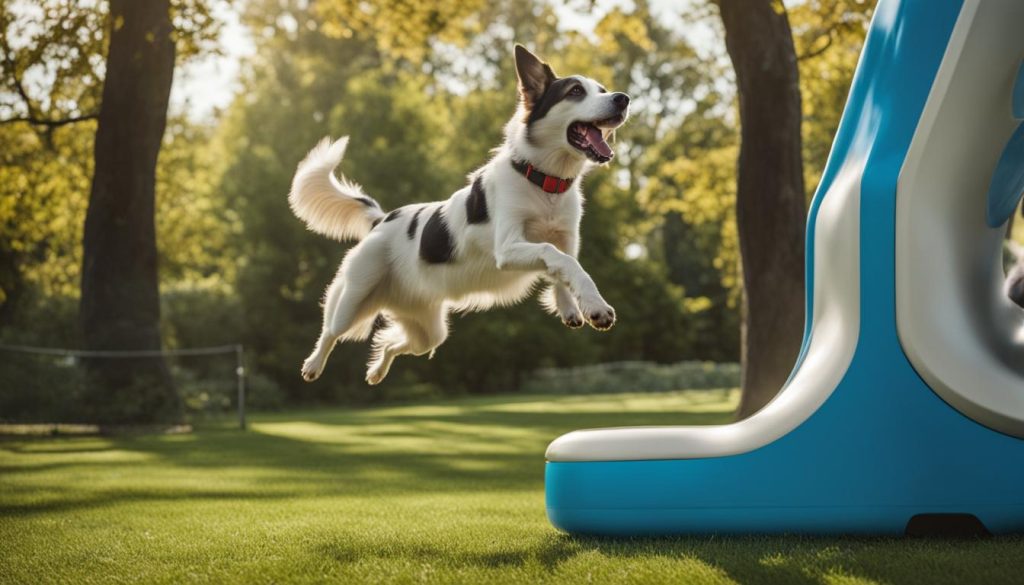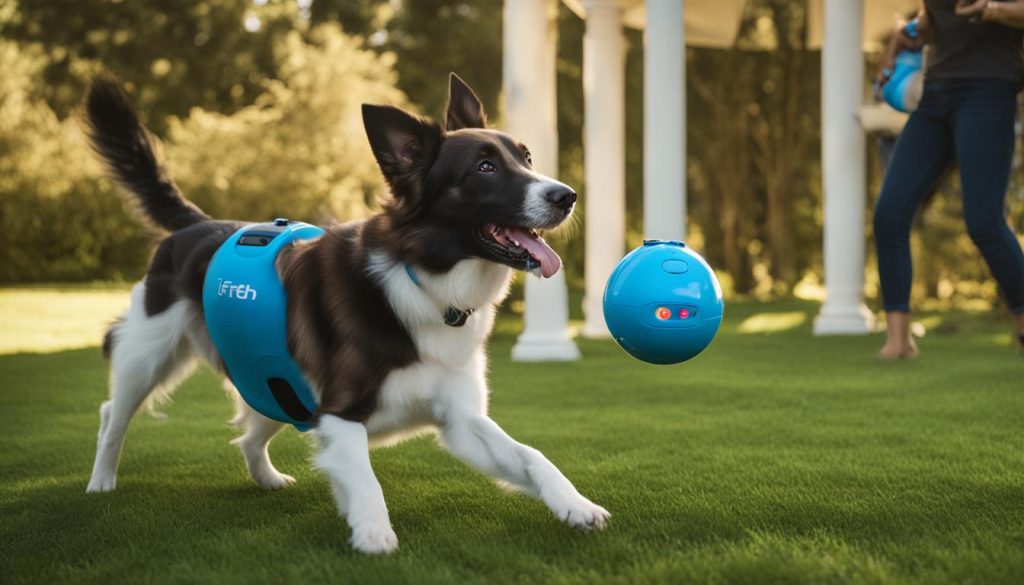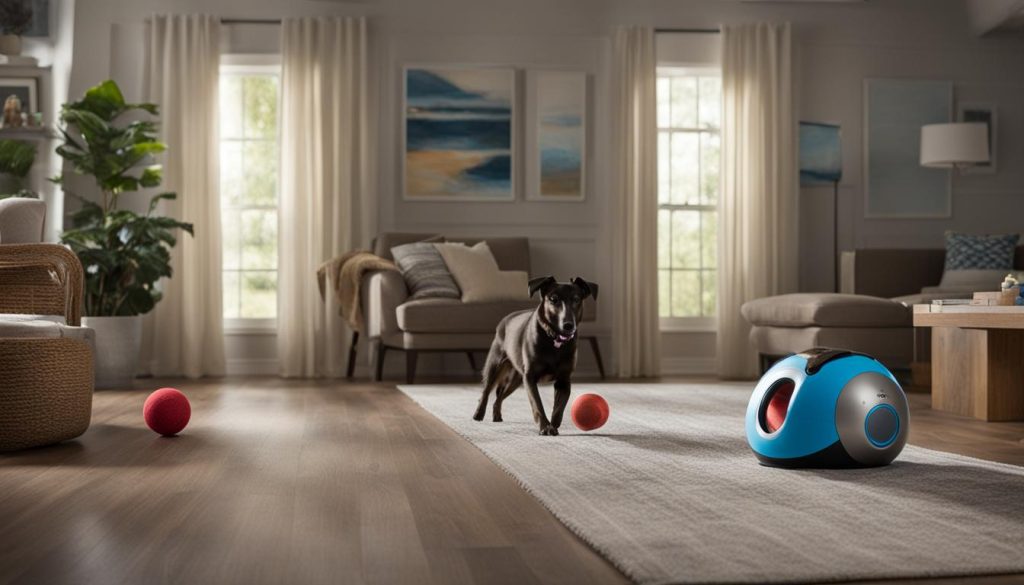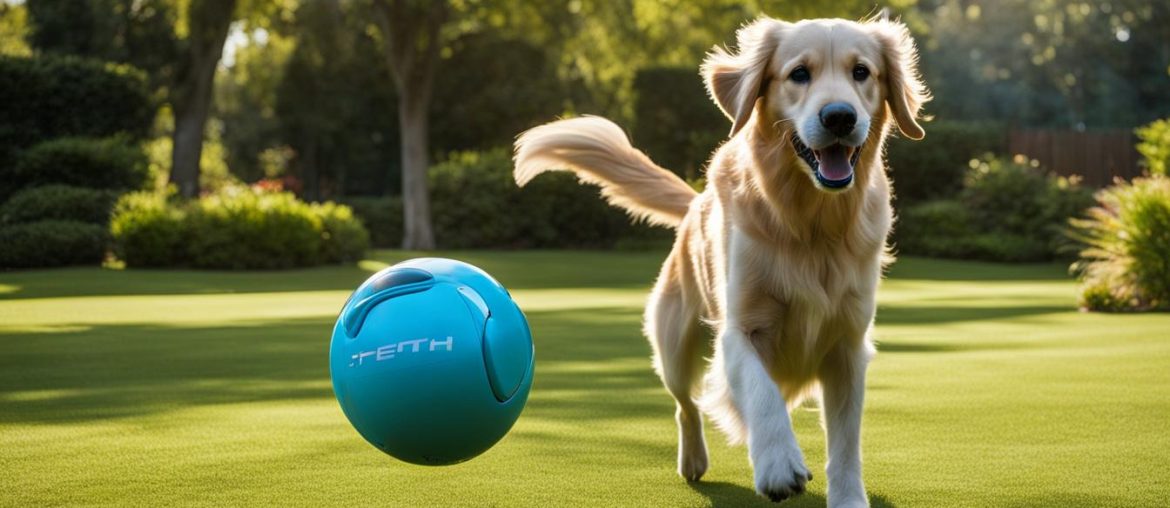If you have a ball crazy dog, an automatic ball launcher like iFetch can be a great solution. These devices can be adjusted to launch balls at varying speeds and distances, and some models even allow dogs to learn to operate the launcher themselves. However, supervise your dog when using an automatic ball launcher and acclimatize them to the machine. Use treats and a clicker to help direct and acclimate your dog to the iFetch.
Key Takeaways:
- Teaching your dog to use iFetch provides mental and physical stimulation.
- iFetch can be a great way for your dog to play fetch even when you’re unable to throw the ball yourself.
- Using iFetch strengthens the bond between you and your dog and provides training opportunities.
- Getting started with iFetch training involves selecting the right device and introducing it to your dog gradually.
- Teach your dog to use iFetch by starting with the basic fetch command and gradually increasing difficulty.
Benefits of Teaching Your Dog to Use iFetch
Teaching your dog to use iFetch, an automatic ball launcher, can offer numerous benefits for both you and your furry friend. Let’s explore some of the advantages of iFetch training and why it can be a great addition to your dog’s playtime routine.
First and foremost, iFetch provides your dog with mental and physical stimulation. The interactive nature of the device engages their natural instinct to chase and retrieve, keeping them entertained and active. This can be especially beneficial for high-energy dogs who require regular exercise to prevent boredom and destructive behavior.
Another advantage of using iFetch is the convenience it offers. Even when you’re unable to physically throw the ball, your dog can still enjoy a game of fetch. This is particularly useful when you’re busy or recovering from an injury, as it allows your pup to release their energy without relying on your physical capabilities.
Furthermore, teaching your dog to use iFetch can strengthen the bond between you and your furry companion. By spending quality time together during training sessions, you’ll build trust and reinforce positive behavior. This shared activity can enhance your relationship and provide an opportunity for mutual enjoyment.
Overall, the benefits of iFetch training are multifaceted. It provides mental and physical stimulation for your dog, offers convenience for playtime, and strengthens your bond. So why not introduce iFetch to your furry friend and watch them have a ball!

Table: Comparison of Different iFetch Models
| Model | Number of Balls | Throw Distance | Power Options |
|---|---|---|---|
| iFetch Mini | 3 | 10-30 feet | Battery |
| iFetch Original | 3 | 10-30 feet | Plug-in or Battery |
| iFetch Too | 3 | 10-40 feet | Plug-in or Battery |
Table: Comparison of Different iFetch Models
| Model | Number of Balls | Throw Distance | Power Options |
|---|---|---|---|
| iFetch Mini | 3 | 10-30 feet | Battery |
| iFetch Original | 3 | 10-30 feet | Plug-in or Battery |
| iFetch Too | 3 | 10-40 feet | Plug-in or Battery |
Getting Started with iFetch Training
If you’ve decided to teach your dog to use iFetch, start with the right steps to ensure successful training. Introducing your dog to iFetch requires patience, positive reinforcement, and careful acclimation to the device. Follow these initial steps to get started with iFetch training:
- Choose the right iFetch model: Select an iFetch model that suits your dog’s size and playing preferences. Consider factors such as ball capacity, distance settings, and power options.
- Read the instructions: Familiarize yourself with the instructions provided with the iFetch. Pay close attention to safety guidelines and operating procedures.
- Find a safe space: Set up the iFetch in a safe and open area free from hazards. This will allow your dog to move around comfortably and retrieve the ball without obstacles.
- Introduce your dog to iFetch: Use treats and positive reinforcement to introduce your dog to the iFetch. Allow them to sniff the device and associate it with positive experiences. Show them where to stand to retrieve the ball.
- Gradually acclimate your dog: Start with short distance launches and slow speeds to help your dog become comfortable with the sights and sounds of the iFetch. Increase the difficulty gradually as your dog gains confidence.
By following these initial steps, you can lay the foundation for successful iFetch training. Try to be patient, provide positive reinforcement, and always prioritize your dog’s safety throughout the training process.
Table: iFetch Training Steps
| Step | Description |
|---|---|
| 1 | Choose the right iFetch model for your dog’s size and preferences. |
| 2 | Read the instructions carefully to understand safety guidelines and operation procedures. |
| 3 | Set up the iFetch in a safe and open area, free from hazards. |
| 4 | Introduce your dog to the iFetch using treats and positive reinforcement. |
| 5 | Start with short distance launches and slow speeds to acclimate your dog gradually. |
With these initial steps and proper training, your dog will soon be ready to enjoy the fun and exercise that iFetch provides. Keep in mind that each dog learns at their own pace, so be patient and adjust the training to suit your dog’s needs. Now that you’re familiar with the starting process, it’s time to move on to teaching your dog how to use iFetch effectively.
Teaching Your Dog to Use iFetch
Training your dog to use iFetch can be a rewarding and fun experience for both you and your furry friend. By following a few simple steps, you can successfully teach your dog to retrieve balls with iFetch. Here are the training steps for iFetch:
- Start by teaching your dog the basic fetch command. Use positive reinforcement, treats, and a clicker to reward your dog for fetching and releasing the ball to you.
- Introduce the iFetch by placing the ball in the machine and encouraging your dog to retrieve it. Use treats and praise to reward your dog for engaging with the iFetch.
- Gradually increase the distance and speed of the launches as your dog becomes more comfortable and proficient with the iFetch. Continue to use positive reinforcement to reward your dog for successful retrieval.
- Practice regularly with your dog to reinforce their training and improve their skills. Make the training sessions fun and exciting to keep your dog motivated and eager to play with iFetch.
To put it simply, patience and consistency are key when teaching your dog to use iFetch. Every dog learns at their own pace, so be sure to tailor the training to your dog’s individual needs and abilities. With dedication and positive reinforcement, your dog will soon become a pro at ball retrieval with iFetch.

Troubleshooting iFetch Training
Teaching your dog to use iFetch can be a fun and rewarding experience, but it’s not without its challenges. Some dogs may have difficulty acclimating to the machine, while others may exhibit problem behaviors during training. However, with the right approach and a little patience, you can overcome these common issues and ensure successful iFetch training.
One common challenge is dogs having difficulty releasing the ball into the machine. This can be due to anxiety or unfamiliarity with the iFetch. If your dog is struggling with this step, you can have them release the ball to you instead. Gradually reintroduce the iFetch and encourage your dog to drop the ball closer to the machine until they feel comfortable with it.
Another issue that may arise is possessiveness or play-aggression towards the ball. Some dogs may become possessive of the iFetch balls, guarding them or exhibiting aggression towards other dogs or people. I recommend that you address this behavior before introducing group play with the iFetch. Work with your dog individually, using positive reinforcement and reward-based training, to overcome possessiveness and promote cooperative play.
“Patience and positive reinforcement are key when troubleshooting iFetch training.”
To ensure successful iFetch training, here are a few tips:
- Start with shorter distances and slower speeds, gradually increasing the difficulty as your dog becomes more confident.
- Use treats and positive reinforcement to reward your dog for engaging with the iFetch.
- Supervise your dog closely during training to ensure their safety and prevent any problem behaviors from escalating.
- Be consistent in your training approach and maintain a positive and patient attitude.
To put it simply, every dog is unique, and troubleshooting iFetch training may require individualized strategies. If you’re facing persistent challenges, consider seeking guidance from a professional dog trainer who can provide personalized advice and assistance.

Playing with iFetch in a Group
Playing with iFetch in a group can be a fun and engaging activity for both dogs and their owners. It provides an opportunity for multiple dogs to participate in interactive playtime, promoting socialization and teamwork. However, proper supervision and guidelines are essential to ensure everyone’s safety and a positive experience.
When playing iFetch with multiple dogs, establish ground rules and ensure that each dog gets a fair chance to participate. One approach is to have one dog take on the role of the “ball-dropper-in-chief” while the others retrieve the balls. This rotation allows each dog to take turns and prevents any potential possessiveness or play-aggression.
Another option is to have all dogs take turns retrieving the balls, creating a friendly competition among them. This can be a great way to encourage their natural instinct to chase and retrieve, while also providing mental and physical stimulation. However, please closely monitor their interactions and step in if any signs of tension or conflict arise.

Using iFetch Indoors and Outdoors
When it comes to using iFetch, you have the flexibility to play both indoors and outdoors, depending on the available space and your preference. Whether you want to engage your dog in a lively game of fetch inside your home or let them enjoy the fresh air and wide-open spaces of your backyard, iFetch is designed to accommodate both settings.
The iFetch device has distance settings that allow you to adjust the throw distance according to the space you’re playing in. This feature ensures that you can set the appropriate distance for indoor play, keeping the ball within a safe and manageable range. On the other hand, when using iFetch outdoors, you can set it to throw the ball at a longer distance, providing more challenge and exercise for your dog.
Additionally, iFetch offers different power options to suit your needs and location. You can plug the device into a wall socket for unlimited playtime without worrying about running out of power. Alternatively, if you prefer a wireless experience or want to take iFetch to places without access to electricity, you can use batteries to power the device. This gives you the freedom to play with your dog wherever you choose.
So whether you’re looking for an energetic indoor play session on a rainy day or want to enjoy the great outdoors with your furry friend, iFetch offers the versatility to cater to your preferences. With adjustable distance settings and power options, you can customize the play experience for your dog and create endless moments of fun and excitement.

| Benefits of Using iFetch Indoors and Outdoors |
|---|
| Allows for playtime in any weather conditions |
| Provides mental and physical stimulation indoors and outdoors |
| Adjustable distance settings for safe and challenging play |
| Power options for both wired and wireless play |
| Promotes a healthy bond between you and your dog |
Tips for Successful iFetch Training
Training your dog to use iFetch can be a fun and rewarding experience for both you and your furry friend. To ensure successful training, here are some tips and best practices:
- Start with a positive mindset: Don’t forget that patience and positive reinforcement are key to successful iFetch training. Approach each training session with enthusiasm and a positive attitude, as your dog will pick up on your energy.
- Use treats and rewards: During training, use small, tasty treats to reward your dog for engaging with the iFetch. This will help them associate the device with something positive and reinforce the desired behavior.
- Gradually increase difficulty: Start with shorter distances and slower ball launches, and gradually increase the difficulty as your dog becomes more comfortable and proficient. This will prevent them from becoming overwhelmed or frustrated and ensure steady progress.
- Consistency is key: Regular and consistent training sessions will yield the best results. Aim for short, frequent training sessions rather than long, sporadic ones. This will help your dog build muscle memory and reinforce the desired behaviors.
To put it simply, every dog learns at their own pace, so be patient and adapt the training to suit your dog’s individual needs. Celebrate small victories along the way and have fun bonding with your canine companion through the iFetch training process.
Common challenges and how to overcome them:
While iFetch training can be relatively straightforward, there may be some challenges along the way. Here are a few common issues and tips for overcoming them:
- Ball possession: If your dog is possessive of the ball and reluctant to release it into the iFetch, work on their “drop it” command separately before introducing the iFetch. Use positive reinforcement and rewards to encourage them to let go of the ball willingly.
- Nervousness or anxiety: Some dogs may be hesitant or anxious around the iFetch, especially when it’s powered on or making noises. Gradually acclimate your dog to the device by allowing them to approach it at their own pace, giving treats and praise for positive interactions.
- Group play dynamics: When playing with the iFetch in a group setting, make sure to monitor the dogs closely to prevent any possessiveness or play aggression. Allow each dog to take turns and ensure that all interactions remain safe and positive.
By following these tips and overcoming common challenges, you’ll be well on your way to successful iFetch training. Try to enjoy the process and have fun bonding with your dog through this engaging and interactive activity.

Choosing the Right iFetch Model
When selecting an iFetch model for your dog, consider their size, playing preferences, and any specific needs or limitations they may have. There are different models of iFetch available, each with its own unique features and specifications that cater to different dogs and environments.
Table: Comparison of iFetch Models
| iFetch Model | Number of Balls | Throw Distance | Power Options |
|---|---|---|---|
| iFetch Mini | 3 | 10-20 feet | Battery operated |
| iFetch Original | 3 | 10-30 feet | AC adapter or battery operated |
| iFetch Too | 3 | 10-40 feet | AC adapter or battery operated |
The iFetch Mini is ideal for smaller dogs, with a throw distance of 10-20 feet and a compact design that suits indoor play. The iFetch Original offers a slightly longer throw distance of 10-30 feet, making it suitable for medium-sized dogs and both indoor and outdoor use. For larger dogs or those who love a more vigorous game of fetch, the iFetch Too is the best choice, with a throw distance of up to 40 feet.

Consider the power options of each model as well. The iFetch Mini operates on batteries, providing portability and flexibility for use in any location. The iFetch Original and iFetch Too can be powered by an AC adapter or batteries, giving you the option to use them indoors or outdoors without the need for a power outlet.
By comparing the different iFetch models and considering your dog’s size, play style, and where you plan to use the device, you can choose the iFetch model that best suits your dog’s needs and provides them with endless hours of fetch and fun.
Final Thoughts
To sum it up, teaching your dog to use iFetch can be a rewarding and enjoyable experience for both you and your furry friend. With the right training techniques and positive reinforcement, you can help your dog develop the skills needed to put the ball in iFetch and engage in endless hours of fetch play.
iFetch provides numerous benefits, including mental and physical stimulation for your dog, even when you’re unable to throw the ball yourself. It can also strengthen the bond between you and your pet, as well as provide opportunities for training and reinforcement.
When starting iFetch training, ensure that you carefully follow the instructions and acclimate your dog to the machine using treats and positive reinforcement. Gradually increase the difficulty level as your dog becomes more comfortable and proficient. Try to prioritize your dog’s safety and supervise them closely during play.
Choose the right iFetch model for your dog, considering factors such as size, playing preferences, and available space. Reviews and comparisons can help you make an informed decision. By selecting the appropriate iFetch model and providing consistent training, you’ll create a fun and engaging experience for both you and your furry companion.
FAQ
How do I teach my dog to use iFetch?
To teach your dog to use iFetch, start by introducing them to the machine using treats and positive reinforcement. Gradually acclimate them to the sights and sounds of iFetch and teach them the basic fetch command. Once they have mastered this, place the ball in the machine and encourage your dog to retrieve it. Use treats and positive reinforcement to reward your dog for engaging with iFetch and gradually increase the difficulty as they become more comfortable and proficient.
Can I use iFetch indoors and outdoors?
Yes, iFetch can be used both indoors and outdoors. The device has distance settings that allow you to adjust the throw distance, making it suitable for indoor use. When using iFetch outdoors, you can set it to throw the ball at a longer distance, providing more challenge for your dog. iFetch can be powered by plugging it into a wall or using batteries, giving you flexibility in where you use it.
What are the benefits of teaching my dog to use iFetch?
Teaching your dog to use iFetch provides them with mental and physical stimulation, helps burn off excess energy, and strengthens the bond between you and your dog. It also allows your dog to play fetch even when you’re unable to throw the ball yourself, and provides opportunities for training and reinforcement.
What should I do if my dog is having difficulty acclimating to iFetch?
If your dog is having difficulty acclimating to iFetch, be patient and provide plenty of positive reinforcement. Start with shorter distances and slower speeds, and gradually increase the difficulty as your dog becomes more confident. If your dog is possessive of the ball or play-aggressive, you may need to work with them individually before introducing group play with iFetch.
How do I choose the right iFetch model?
There are different models of iFetch available, each with its own features and specifications. Consider factors such as the number of balls the device can hold, the distance and speed settings, and the power options. Read reviews and compare features to choose the iFetch model that best suits your dog’s size and playing preferences.






